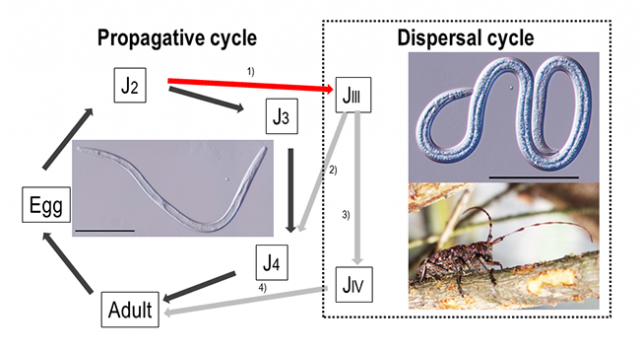Home > Research > Research Results > Research Results 2018 > New approach for pine wilt prevention technology: elucidation of conditions for the emergence of dispersal nematodes
Update:January 22, 2018
Main content starts here.
New approach for pine wilt prevention technology: elucidation of conditions for the emergence of dispersal nematodes
| Article title |
Artificial induction of third-stage dispersal juveniles of Bursaphelenchus xylophilus using newly established inbred lines |
|---|---|
| Author (affiliation) |
Suguru E. Tanaka (a), Takuya Aikawa (b), Yuko Takeuchi-Kaneko (c), Kenji Fukuda (a), Natsumi Kanzaki (d) (a) The University of Tokyo, Tokyo, Japan. (c) Kyoto University, Kyoto, Japan. (d) Kansai Research Center,FFPRI, Kyoto, Japan. |
| Publication Journal |
PLos ONE, 12(10) : e0187127, October 2017, DOI:10.1371/journal.pone.0187127( External link ) |
| Content introduction |
Bursaphelenchus xylophilus (pine wood nematode: PWN), the causal agent of pine wilt disease, is transferred from dead to healthy pine trees by a specise of longhorn beetle, Monochamus alternatus (Japanese pine sawyer: JPS). This nematode has two different life cycle forms: propagative and dispersal forms. The emergence of the latter form in dead trees is essential for the disease to be transmitted to healthy pine trees. The dispersal form consists of two different stages of juveniles: dispersal third- and fourth-stage juveniles (JIIIs and JIVs, respectively). The JIVs, which are carried by JPS, are developed solely from the JIIIs. To date, many studies have been conducted on JIVs, revealing that the chemical substances released by JPS pupae induce the stage. However, little experimental information is available regarding the induction of JIIIs. In this study, we developed genetically homogenous nematode lines (inbred lines) and cultured them under different concentrations of nutrients and additives to artificially induce JIIIs and revealed that the stage is induced by culturing in a low-concentration nutrient medium supplemented with nematode secretions. This suggests that JIIIs emerge in an environment unfavorable for the survival of nematodes, i.e., the nematode density is high under conditions of low nutrient concentrations. In addition, the dispersal form of the nematode appears in different proportions in different inbred lines, indicating that a relatively small number of genes are involved in the emergence of dispersal juveniles. The dispersal third stage is considered to be an important stage for the survival of PWNs inside dead trees. Based on the results of this study, we aim to further clarify the chemical and genetic factors related with the emergence of the JIIIs and apply the information to the development of new control means, such as the inhibition of the emergence of JIIIs.
Figure. In the propagation cycle, first-stage (first-instar) juveniles exuviate into second-stage (second-instar) juveniles (J2) inside the eggs, which then hatch and grow into adults through third and fourth stage propagative juveniles (J3 and J4, respectively). In the present study, we found that the dispersal third-stage juveniles (JIIIs) could be induced when the concentration of nematode secretions was increased and food availability was decreased. JIIIs undergo molting to dispersal fourth-stage juveniles (JIVs) in response to chemical signals from longhorn beetles (lower right). The photographs show a propagative third-stage juvenile (left) and JIII (upper right). Dispersal juveniles are larger and store fat in the body to prepare for long-term survival. The scale bar indicates 0.1mm. 1) JIIIs occur under conditions of increased concentrations of nematode secretions and decreased food availability. 2) The juveniles return to the normal propagation cycle when these abovementioned conditions are resolved. 3) JIIIs molt to JIVs in response to chemical signals from longhorn beetles. 4) JIVs enter the longhorn beetles, disperse, and subsequently infect healthy pine trees where they exuviate into adults. |
Copyright © Forest Research and Management Organization. All rights reserved.

